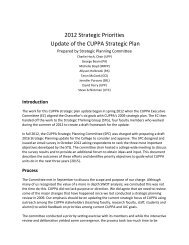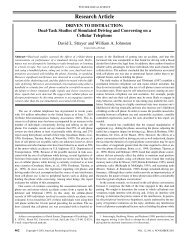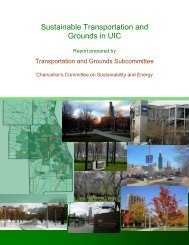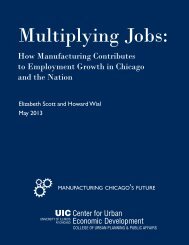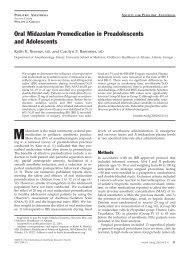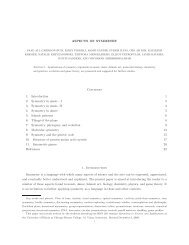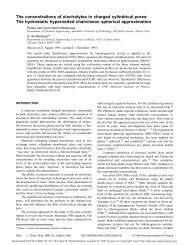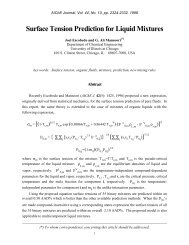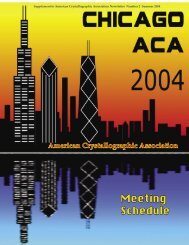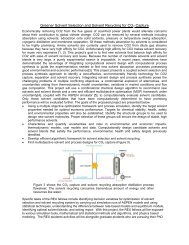High Levels of Gene Flow in Bur Oak Revealed by Paternity ...
High Levels of Gene Flow in Bur Oak Revealed by Paternity ...
High Levels of Gene Flow in Bur Oak Revealed by Paternity ...
You also want an ePaper? Increase the reach of your titles
YUMPU automatically turns print PDFs into web optimized ePapers that Google loves.
Figure 2.<br />
Cont<strong>in</strong>ued.<br />
ternal trees ( 2 1.3, df 2, P .4).<br />
Therefore differences <strong>in</strong> poll<strong>in</strong>ations<br />
would not be a direct result <strong>of</strong> more or<br />
fewer neighbor<strong>in</strong>g trees. Tree 3E had 11<br />
poll<strong>in</strong>ations from near trees and 36 poll<strong>in</strong>ations<br />
from with<strong>in</strong>-stand trees more than<br />
50 m away (‘‘distant’’). Tree 17M had 8<br />
near and 15 distant poll<strong>in</strong>ations, and tree<br />
33W had 23 near and 12 distant poll<strong>in</strong>ations.<br />
A chi-square test <strong>of</strong> association for<br />
the number <strong>of</strong> poll<strong>in</strong>ations <strong>in</strong> the two distance<br />
classes revealed significant differences<br />
<strong>in</strong> the number <strong>of</strong> apparent poll<strong>in</strong>ations<br />
from trees 50 m or closer and those<br />
with<strong>in</strong> the stand but more than 50 m away<br />
( 2 15.3, df 2, P .001). Tree 3E had<br />
fewer near poll<strong>in</strong>ations than expected <strong>by</strong><br />
chance, tree 17M was close to expected,<br />
and tree 33W had more than expected<br />
near poll<strong>in</strong>ations. Although the number <strong>of</strong><br />
trees with<strong>in</strong> 50 m was not significantly different,<br />
the spatial pattern <strong>of</strong> these trees<br />
was not the same. Trees around tree 33W<br />
were closer overall than neighbors <strong>of</strong> the<br />
other trees. The mean distance between<br />
tree 33W and trees with<strong>in</strong> 50 m is 18.4 <br />
10.1 m. (SD) while mean distances to<br />
neighbors with<strong>in</strong> 50 m is 44.3 9.5 m for<br />
tree 17M and 44.7 4.3 m for tree 3E.<br />
These distances are significantly different<br />
(Kruskal–Wallis H test, P .0089). Tree<br />
33W, then, is the only tree to receive pollen<br />
frequently from its neighbors, and its<br />
neighbors are closer than neighbors <strong>of</strong> the<br />
other two trees. These results suggest that<br />
a near-neighbor advantage may exist over<br />
very short distances, but disappears with<strong>in</strong><br />
about 45 m.<br />
The mean distances <strong>of</strong> pollen donors<br />
from trees 3E and 17M were longer than<br />
for tree 33W. The mean distance between<br />
tree 3E and its pollen donors was 68.6 <br />
22.9 m (SD) for unambiguous matches and<br />
75.3 28.7 m for all matches. For tree<br />
17M, mean distance was 79.6 44.7 m<br />
(unambiguous) or 88.8 49.6 m (all). Tree<br />
33W had the shortest mean distances and<br />
the highest variability at 64.3 82.4 m for<br />
unambiguous matches and 63.0 70.8 m<br />
for all matches. These differences are not<br />
significant for the unambiguous matches,<br />
but are highly significant for all matches<br />
(Kruskal–Wallis H test, P .0044).<br />
The Spearman rank correlation coefficient<br />
was used to exam<strong>in</strong>e the relationship<br />
between <strong>in</strong>dividual poll<strong>in</strong>ation success<br />
and distance from the maternal tree. The<br />
number <strong>of</strong> acorns poll<strong>in</strong>ated <strong>by</strong> <strong>in</strong>dividual<br />
trees <strong>in</strong> the stand ranged from 0 to 9, with<br />
a mode <strong>of</strong> 0, so there were many tied<br />
ranks. It was therefore appropriate to correct<br />
the correlation coefficient for ties<br />
(Ebdon 1985). Given the previously discussed<br />
cluster<strong>in</strong>g <strong>of</strong> pollen donors around<br />
tree 33W, it was not surpris<strong>in</strong>g that the<br />
Spearman coefficient was significant for<br />
the association <strong>of</strong> fertilization and distance<br />
from the maternal tree (r s 0.35,<br />
P .008). The negative value <strong>of</strong> the correlation<br />
<strong>in</strong>dicates an <strong>in</strong>verse relationship,<br />
that is, closer trees fertilize more seeds.<br />
Also as might be expected, pollen donors<br />
<strong>of</strong> tree 17M showed no significant correlation<br />
between distance and the number<br />
<strong>of</strong> fertilizations (r s 0.05, P .72). Although<br />
tree 3E seemed similar to tree 17M<br />
<strong>in</strong> tests <strong>of</strong> cluster<strong>in</strong>g and neighbor fertilizations,<br />
trees contribut<strong>in</strong>g pollen to this<br />
tree had the strongest association <strong>of</strong> distance<br />
and number <strong>of</strong> fertilizations <strong>of</strong> the<br />
three trees studied, although the relationship<br />
was still fairly weak (r s 0.45, P <br />
.0005). Thus, while a large proportion <strong>of</strong><br />
effective pollen did not come from trees<br />
with<strong>in</strong> 50 m <strong>of</strong> the tree, the overall trend<br />
for the entire stand <strong>in</strong>dicates that near<br />
trees had a fertilization advantage over<br />
distant trees <strong>in</strong> mat<strong>in</strong>g with tree 3E. In this<br />
analysis <strong>of</strong> fertilization from with<strong>in</strong> the<br />
stand, it is important to bear <strong>in</strong> m<strong>in</strong>d that<br />
more than half <strong>of</strong> the acorns from any tree<br />
were fertilized <strong>by</strong> pollen from outside the<br />
stand.<br />
Discussion<br />
Each microsatellite locus <strong>in</strong> this study was<br />
highly variable. The number <strong>of</strong> alleles per<br />
Dow and Ashley • <strong>Bur</strong> <strong>Oak</strong> <strong>Gene</strong> <strong>Flow</strong> 67




